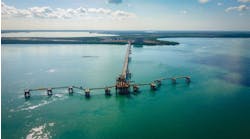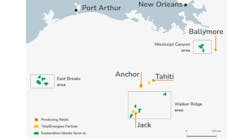MANAGEMENT & ECONOMICS:Insurance market woes may affect future of offshore
William Furlow
Editor-in-Chief
The situation in the offshore surety bond market is worsening by the week, with no hope for improvement in sight. This was the news delivered at the last meeting of the National Ocean Industries Association. Roy C. Die, president of Underwriters Indemnity, which writes more of these surety bonds than any other company, said a number of factors are lining up to devastate the offshore surety market.
Before the US Minerals Management Service will allow a lessee to operate on an offshore field, it requires the posting of a surety bond. An insurance company provides the bond and insures that the lessee will plug and abandon wells, remove platforms and other facilities, and clear the lease site sea floor once operations are complete.
If the lessee performs these activities, the bond is released. The bond protects the MMS in case the lessee is unable to complete activities. Otherwise, the MMS has to assume these costly activities at taxpayer expense. When companies divest a lease, the assignor of the lease as well as the new lessee remains responsible for all the wells and facilities that existed at the time of the assignment of interest. This responsibility continues until the wells are P&A'd, the facilities removed, and the site reclaimed.
Bonding requirements
There are three tiers of bonds, according to NOIA. When no operations are underway on a field, the MMS requires a $50,000 bond on each lease, or $300,000 to cover an entire area. The second tier, in which exploration is underway, requires a $200,000 bond per lease, or $1 million area-wide to cover a proposed exploration plan. The top tier covers development and production activities and consists of a $500,000 bond for a single lease or $3 million area-wide. Beyond this, the MMS regional director can raise the bonding level on a case-by-case basis.
How did we get here?
The overall insurance market has grown tight over the last few years. Increasing losses and decreasing investment returns have further hardened this market. Several high-profile bankruptcies, including Kmart, Superior National, PG&E, and Friede Goldman have further impacted the market as claims deplete capital and affect premiums as well as the level of coverage. More recent events, including the Tyco and WorldCom bankruptcies, may have additional impact on the market, though Die said it is too soon to tell.
While a surety bond is basically a three-party contract, in which the insurance provider guarantees the performance of the insurer to the insuree, it is only one aspect of the offshore insurance market. There is also traditional insurance against catastrophes. This market has received a number of major blows, from the sinking of the P-36 offshore Brazil, to the catastrophe of the Sept. 11 attacks and the damage caused by tropical storms. Because most institutions write both surety and traditional insurance, both affect the availability of capital.
"All of these things have impacted the insurance industry," Die said.
The insurance industry has two main sources of revenue – premiums and investment returns. Insurance companies keep a certain amount of capital backlogged to cover claims. Much of this money is invested to generate returns while it is being held. With the recent decline in the stock market, returns from these investments are down.
Mezzanine financing
The Enron collapse forced banks to watch their clients more closely. Specifically, the banks are monitoring the hedge funds of clients for whom they provide financing. The banks' lending decisions are still based on the classic drivers. The mezzanine financing has been hardest hit by the shift in financing. These markets traditionally provide financing for independent operators. As this source of funding dries up, it will be difficult for independent operators to find the capital they need to do business. Without access to the mezzanine funds, smaller operators lack the resources to purchase sunset fields from operators, a situation made worse by the tightening surety market.
This means the majors may have difficulty discarding such fields and will instead be forced to P&A the fields themselves. Not only is this costly for the major operator, but it leaves quite a bit of untapped potential in the ground because most majors cannot profitably reenter or work over these fields to maximize late-in-life production, something the independents specialize in.
Results
With a tighter capital market, insurance premiums are being driven up, and there are an increasing number of exclusions in the policies that are written. In fact, a number of insurance companies, including Reliance, Amwest, and Frontier, have gone out of business, while others are restricting the writing of commercial bonds. This, in turn, puts further pressure on the remaining providers who are forced to write more bonds. These costs are then taken on by operators in the projects that go forward and may eventually trickle down to increase oil and gas prices.
As states follow the federal government lead in increasing P&A bonding requirements in their waters and onshore, it could put a capacity strain on the surety companies. Insurance providers can write only so many of these bonds before reaching their capacity. In cases where a bond cannot be written, the operator must put up cash to cover the requirements. This can be very costly, as the cash used for the bond impacts the cash available for the E&P activities.
"There is going to be a curtailment of exploration because of this," Die said. In addition, this will tax the resources of operators, leading to more defaults and orphaned wells. Ironically, this would worsen the situation the bonds are designed to improve. If the government has to P&A these wells because its bonding requirements are too high, it costs the taxpayers more in the long run.
Eventually, Die said, more cash will enter this market, but in the meantime there is no easy solution to these problems. It is important for the regulators to recognize this and to consider the burden their requirements put on smaller operators. Regulators also need to understand that the insurance market can write only so many surety bonds at any given time.
One area that could provide relief to this market is the more rapid release of sureties. Die said it is difficult for insurance companies to get releases from their bonds once a project is completed successfully. This not only limits the money available to write new bonds, but also makes insurers reluctant to enter the oil and gas market.
These bonds must be written with an exit plan in mind, he said. The majors also have to consider the target market for their divestitures. If these properties are to be sold to smaller independents, then it is important that they are affordable and can be bonded. The majors often require double bonding on such properties to ensure they will not be affected if the independent is unable to fulfill the P&A requirements. While this provides the majors with a safety net, it imposes a huge burden on the independents trying to purchase and operate these fields. Such requirements make all deals more expensive and tie up additional capital.
Currently, certain large operators are exempt from these bonding requirements in the Gulf of Mexico; however, Die suspects these exemptions will be more difficult to obtain in the future.
In the worst case, a major might have to P&A wells on a property before selling it to an independent. This covers the major's exposure, but forces the independent to basically start from scratch on these prospects, rather than simply reworking existing wells.


